Prevalence and intensity of soil-transmitted helminth infections among school-age children in the Cagayan Valley, the Philippines
Ryan V. Labana, Vimar A. Romero, Analette M. Guinto, Alvin N. Caril, Kimberly D. Untalan, Alejandro Jose C. Reboa, Khristine L. Sandoval, Kristel Joy S. Cada, Gary Antonio C. Lirio, Iris Rowena A. Bernardo,Lanieleen Jerah Mae Arocha, Julieta Z. Dungca
1Department of Biology, College of Science, Polytechnic University of the Philippines, Sta. Mesa, Manila, the Philippines
2Graduate School, Centro Escolar University, Manila, the Philippines
3Center for Life Sciences Research, Institute of Science and Technology Research, Polytechnic University of the Philippines, Sta. Mesa, Manila, the Philippines
4Department of Nutrition and Dietetics, College of Science, Polytechnic University of the Philippines, Sta. Mesa, Manila, the Philippines
5School of Science and Technology, Centro Escolar University, Manila, the Philippines
ABSTRACT
KEYWORDS: Intestinal worms; War on worms; Infectious disease; Neglected tropical diseases
1. Introduction
Soil-transmitted helminthiasis (STH) is one of the most prevalent human infections in tropical countries caused by three major nematodes: Ascaris lumbricoides, Trichuris trichiura, and the hookworms[1]. It infects 24% of the world’s population[2]and it usually persists in low-resource settings where water, sanitation,and hygiene services are sub-standard[3]. In the Philippines, STH remains a major public health concern, particularly among schoolage children (SAC) who are consistently at high risk due to their poor hygiene and sanitation practices[4]. In 2005, a study was conducted to determine the prevalence of STH among SAC across the nation and a cumulative prevalence rate for at least one type of STH infection was reported 67% [5]. Other localized studies also showed consistent high infection rates among the Filipino SAC even up to the recent decades[6-8]. This infection has adverse effects on the children’s growth and development, cognitive potential, and nutritional status, which subsequently causes a serious impact on the SAC’s school attendance, learning, and overall well-being[9].
In the pursuit to reduce the mortality and morbidity associated with STH, a resolution was passed during the 54th World Health Assembly (WHA 54.19) in 2001. One action item in the resolution was to provide anthelminthic drugs to the SAC and other highrisk groups[10]. The aim was to cover at least 75% of the SAC population in the endemic countries by the end of 2010, but this was not achieved so a new global effort was introduced in 2011.The London Declaration on Neglected Tropical Diseases was endorsed by the collective public and private sectors to sustain and expand the goal to eliminate STH as a public health issue by 2020[11,12].In the Philippines, the Department of Health has formulated the Integrated Helminth Control Program (IHCP) since 2006 as a notable intervention for STH control. With the cooperation of the Department of Education, it has implemented mass treatment with albendazole in a harmonized mass drug administration(MDA) across different regions in the country. It is primarily being implemented at school twice a year: during the class opening in July and a follow-up in January. Its main goal is to lower the number of SAC with moderate-heavy STH infections[13]. As a preventive chemotherapy, it has been well-participated by the education sector in the country and as of 2016, its coverage in the country has already reached ≥75% [14].
Despite these efforts, its global implementation is challenged by several factors including the issues of consistency and sustainability in the enforcement, lack of resources, and refusal to participate by some individuals due to some misconceptions and cultural barriers[14]. Other challenges include the risk of anthelmintic drug resistance[15]and the low efficacy of drugs like in the case of a single dose treatment for T. trichiura[16]. The impact of the program is also not well documented, since the monitoring scheme is insufficient and the relevant data are not readily available[17]. In the Philippines, IHCP was evaluated 10 years after its implementation in an identified area where it was introduced. The evaluation was conducted by a research group from the University of the Philippines, which showed unsatisfactory results in achieving global and national targets on deworming coverage and decreasing the rates of moderate-high infections[18]. No updated records have been found regarding the impact of IHCP at a national level. As year 2020 had past, an efficient method to fully understand the impact of the program is still not available. Therefore, it is important to create other intervention strategies that cover an integrated approach to health education and hygiene improvement, which have potential outstanding results at a reasonable period of time. In Malaysia, for example, a Health Education Learning Package, which displayed comic books, music videos, and puppet shows, achieved a significant impact on reduction of the infection[19]. In China, a cartoon video called “The Magic Glasses” increased the students’ knowledge of STH. It led to behaviour modifications toward hygiene and sanitation, which subsequently caused a reduction of STH infection rates among SAC[20]. A version of this cartoon video called “Koko et les lunettes magiques” was developed and displayed in C?te d’Ivoire.It also showed promising results among the group who were exposed to the educational video[21].
However, other innovative interventions for STH control is not well-studied in the Philippines. To address this call, other possible options that can be used by Filipino SAC should be explored. This study was conducted to assess the needs in designing other possible interventions. The schools in the Cagayan Valley, endemic for STH,were purposively chosen to be the research site of this study due to the lack of attention it incurred, as reflected on a scanty number of studies conducted in the area. The earliest record of STH infection(among adults) in the Cagayan Valley was reported in 1911 by Willets. Of 4278 fecal samples, 62.4% were infected with A.lumbricoides, 54.37% with hookworm, and 7.99% with T. trichiura,for a cumulative prevalence rate of 85.46% for any type of helminth infections[22]. In 2015, after more than a hundred years from the earliest report, the Cagayan Valley still has a 20%-50% predicted prevalence based on the mapping of STH risks in the country[4]. The goal of this study is to identify the updated prevalence and intensity of STH infections among SAC in the area, and assess their levels of knowledge, attitude, and practices towards the disease so future plans can be laid-out, particularly on the production of a revolutionary tool as a supplement to the global effort in eliminating STH as a public health issue.
2. Subjects and methods
2.1. Study setting and population
The region of the Cagayan Valley is located at the northwestern tip of the Philippines. The study was conducted in the public elementary schools from the two school districts of Cagayan, selected via random sampling, Pamplona and Sanchez-Mira. The municipal centre of Pamplona is situated at approximately 18°28’ North 121°20’ East, (elevation at 23.1 feet above mean sea level), with an area of 173.30 km. Sanchez-Mira, on the other hand, is situated at 18°34’ North 121°14’ East (elevation at 27.6 feet above mean sea level), with an area of 198.80 km. Sanchez-Mira has larger annual regular revenue than Pamplona based on the fiscal year 2016. In terms of the age group, 5-9 years old has the highest population in Pamplona, while 10-14 years old in Sanchez-Mira[23]. Eleven elementary schools in Pamplona participated in this study including Allasitan Elementary School (E/S), Cabaggan E/S, San Juan E/S,Abbangkeruan E/S, Pamplona Central E/S, Tabba E/S, Pimpila E/S, Curva E/S, Bidduang E/S, Balingit E/S, and Naggattatan E/S. In Sanchez-Mira, eight public elementary schools have participated including Bangan E/S, Langagan E/S, Nagrangtayan-Macagan E/S,Callungan E/S, C. Marzan E/S, Sanchez-Mira Central E/S, Sanchez-Mira West Central E/S, and Namuac-San Andres E/S.
There were 1345 recorded population of Grades Ⅲ-Ⅴpupils in all participating schools. This population estimate was used in computing the sample size needed for the study. The calculation of sample size was estimated using the online epidemiologic calculator from OpenEpi[24]. A sample of 445 was needed to obtain 99% confidence level (%) based on the equation of the online calculator.Out of 865 total number of Grades Ⅲ-Ⅴpupils from the visited schools in Pamplona, 277 participated in the study; 201 out of 480 in Sanchez-Mira. Overall, 478 (response rate=107.41%) SAC participated in this study coming from the two school districts(Figure 1).
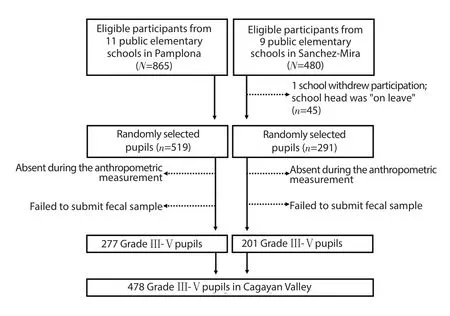
Figure 1. Flowchart of selecting the participants from two school districts.
2.2. School survey management
An ocular visit was conducted a month (October 2018) before the actual data collection. During this visit, the names of all GradesⅢ-Ⅴpupils were gathered from their respective homeroom advisers. From these lists, names of the participants were identified via systematic random sampling with substitution. A week before actual data collection, parental consent was distributed to the identified participants to allot ample time in deciding participation.A comprehensive plan was also communicated to the school officials and teachers for efficient data gathering. Since there were 1 to 3 sections per grade level, and the participation per section was not at 100%, a vacant classroom was assigned for the entire activity.Station 1 was assigned for the registration and the submission of the signed parental consent. It was situated outside the classroom while the participants were falling in line. The anthropometric data were also collected in the same station before the participants entered the room. The desks inside the classroom have knowledge, attitudes,and practices (KAP) questionnaires ready with pencil and eraser(station 2). There were two teachers and two researchers assisted the participants in answering the questionnaire. After completing the questionnaire, the participant was asked to submit it in station 3 where the stool cup was distributed together with a brief explanation on proper sample collection. The appropriate instructions were also printed on a piece of paper as a guide at home. The participant was asked to submit the fecal sample on the following day to receive a token for participation.
2.3. Parasitologic assessment
The stool samples were immediately sent to the Rural Health Unit of Pamplona, the Cagayan Valley (±15 minutes away from the participating schools) for analysis using direct smear (first reading) and Kato-Katz technique (second reading). Microscopic readings were done within 2 h after the faecal sample collection.Approximately 41.7 mg of stool sample was used to describe the presence of STH eggs, qualitatively and quantitatively. Raw egg counts were multiplied by a factor of 24 to derive the number of eggs per gram (epg)[25]. The parasitologic assessments were conducted by the trained microscopists from the Polytechnic University of the Philippines and Centro Escolar University. The accuracy and the reliability of parasitologic assessment were maintained through the quality assurance and slide validation by four professional and experienced Medical Technologists from the Rural Health Unit. All completed samples were preserved in 10% formalin. It was then transported to the Institute of Science and Technology Research Laboratory, Polytechnic University of the Philippines, Manila, for formalin-ether concentration technique (third reading). It was used to ensure detection of helminths from samples with low intensity of infections. The data from the fecal analysis were collected to determine the prevalence rates per STH species. The intensity of infections was reported as epg and was classified as light [(1-4999)epg for A. lumbricoides, (1-999) epg for T. trichiura and (1-1999)for hookworm), moderate (5000-49999) epg for A. lumbricoides,(1000-9999) epg for T. trichiura and (20000-3999) for hookworm],or heavy (≥50000 epg for A. lumbricoides, ≥10000 epg for T.trichiura and ≥4000 for hookworm)[25].
2.4. Questionnaire on knowledge, attitude, and practices of school-age children toward soil-transmitted helminthiasis
A structured questionnaire, developed by Bieri[20], was modified and translated into the Filipino language. The socio-demographic profiles i.e. name, age, date of birth, sex, and grade level were gathered. The questionnaire was designed to capture important aspects of KAP among the population in the sample area. This included respondents’knowledge about STH, its signs and symptoms, and its mode of transmission. It also sought information about the respondent’s attitude toward STH and their hygiene practices. Additionally, the questionnaire captured health education practices at school and sources of SAC’s information about STH. Majority of the questions can be answered by a yes or no, other questions used a likert scale,and few questions are in an open-ended form. This modified and translated questionnaire was answered first by 30 non-respondents Grades Ⅲ-Ⅴpupils before the actual utilization for a face validity testing wherein readability, clarity of language used, consistency of style and formatting, and feasibility were evaluated. The reliability testing was done based on the judgment of the two researchers via inter-rater reliability methods using MS Excel (percentage agreement=90%; Cohen’s Kappa=0.80).
2.5. Nutritional status assessment
Anthropometric data were also taken. Height and weight were measured using a mechanical eye-level physician scale with a height rod. Each SAC was asked to stand at the centre of the scale platform with bare feet and empty pockets. The weight was measured and recorded to the nearest 0.1 kg, while the height was measured and recorded to the nearest 0.1 cm. These anthropometric measurements were classified using the international reference standard, which is used by the Department of Education as a reference. The nutritional status was evaluated based on the weight-for-age/body mass index and height-for-age data. The sums of which were computed to reflect the overall nutritional status of the SAC participants i.e. severely wasted, wasted, normal, overweight, and obese[26].
2.6. Data analysis
Statistical Package for Social Sciences for windows SPSS version 23 (IBM Corp., Armonk, NY, USA) was used to analyse the data.Descriptive statistics were used to assess demographic profiles, and prevalence and intensity of infections. To assess the respondents’KAP toward STH, responses were extracted from the relevant components of the KAP questionnaire. Out of 38 questions, 18 of them measured the ‘knowledge’, four questions measured the ‘a(chǎn)ttitude’, and 8 questions measured the ‘practices’ of the respondents. The other seven questions under the components of‘health education programs at school’ and the ‘SAC’s sources of information about STH’ were reserved to support interpretation of data. Binary logistic regression analysis was conducted to estimate the association between the responses of the SAC in the KAP questionnaire and Ascaris lumbricoides/at least 1 type of STH infection.It intends to answer the question, ‘do responses to KAP questions predict the probability of having STH infection?’. Answer to this question can be used in making future decisions for an intervention approach. The dependent variable is the STH infection (negative=0;positive=1). The independent variables are the KAP responses and were coded as follows: items-of-interest on knowledge about STH(no=0; yes=1), attitude towards STH (strongly disagree/disagree/uncertain=0; agree/strongly agree=1), and hygiene practices (never/very rarely/rarely=0; occasionally/frequently=1). The variables included in the most parsimonious model was selected via a stepwise backward procedure with P values of 0.2 and 0.4 as a threshold in including and eliminating variables. Odds ratios (ORs) and their respective 95% confidence intervals (CIs) were calculated and presented. P values less than or equal to 0.05 was considered statistically significant.
2.7. Ethical consideration
This research was reviewed and approved by the Research Ethical Board of Polytechnic University of the Philippines and Centro Escolar University (IERC 2017-18/048) and by the appropriate authorities including the municipal mayors, school district supervisors, and school heads in the Municipalities of Pamplona and Sanchez-Mira, the Cagayan Valley, the Philippines. Prior to conducting the data gathering, consent letter was ensured to be wellunderstood and be signed by the parents of the SAC-participants. All the information obtained from the study was kept confidential.
3. Results
3.1. Profiles of the participants
Overall, 478 SAC participated in the study. More females (55.86%)than males (44.14%) have completed involvement, which included the anthropometric measurement, completion of a questionnaire,and submission of a fecal sample. Majority of the participants were 10 years old (34.94%), followed by 9 years old (33.26%) and 8 years old (20.92%). Others were 11-14 years old, but with minimal participation rates. Table 1 shows the complete profiles of the participants from the two school districts including their nutritional status. Majority of them were found having “normal” nutritional status (84.31%), but 6.49% were reported “severely wasted” and 1.26% were “obese”.
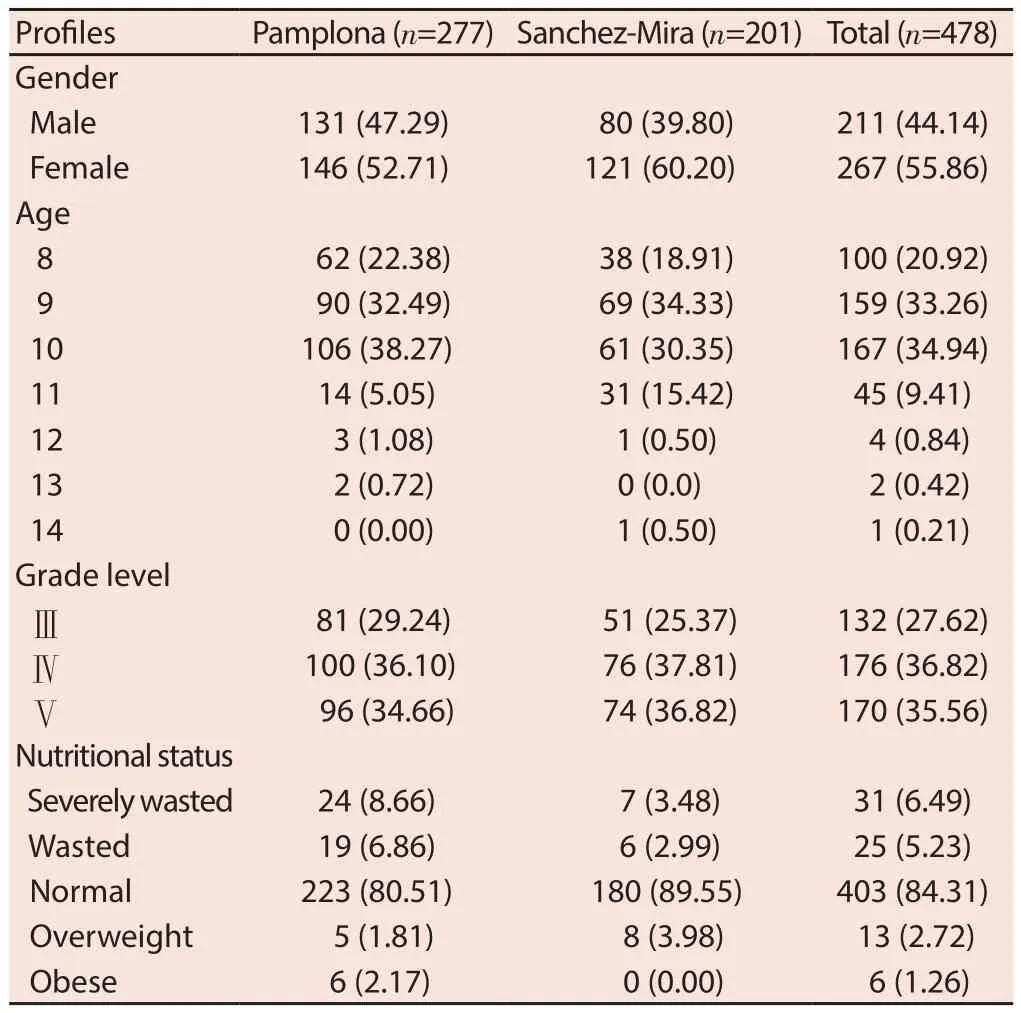
Table 1. Demographic profiles of the school-age children from Pamplona and Sanchez-Mira [n (%)].
3.2. Parasitologic characteristics
A prevalence rate of infection for at least 1 STH was found 25.99% in Pamplona and 19.40% in Sanchez-Mira; for a cumulative prevalence of 23.22%. The prevalence of heavy intensity for A. lumbricoides was 7.11% and for T. trichiura was 1.67%. All hookworm-positive samples showed light intensities. Table 2 presents the cumulative prevalence and heavy intensity infections in both school districts. Multiple infections varied from A. lumbricoides+T.trichiura, A. lumbricoides+hookworm, and T. trichiura+hookworm.There were also two cases of triple infection (0.72%) in Pamplona.From the three STH species, A. lumbricoides was the most prevalent in Pamplona (23.83%) and Sanchez-Mira (15.92%). It was followed by T. trichiura, which has a prevalence rate of 11.55% in Pamplona,and 5.97% in Sanchez-Mira. Hookworm was the least prevalent in either school district with recorded low intensities of infections. Of the 11 elementary schools in Pamplona, 6 did not meet the <20%prevalence threshold set by the WHO in terms of prevalence rate of A. lumbricoides. Cabbagan E/S got the highest prevalence rate of A.lumbricoides at 45.83%. It was followed by Allasitan E/S (34.78%),Bidduang E/S (29.17%), Tabba E/S (29.03%), Naggattatan E/S(28.57%) and San Juan E/S (23.08%). A 20.83% was also observed in Cabbagan E/S for a T. trichiura infection. In Sanchez-Mira, 3 out 8 schools got a prevalence rate of ≥20% for A. lumbricoides,namely: C. Marzan E/S (35.71%), Sanchez-Mira West E/S(22.22%), and Bangan E/S (20.00%). A 21.43% prevalence rate of T. trichiura was observed in C. Marzan E/S. Table 3 also presents the prevalence rates of infections per STH species, per school, with their corresponding geometric mean egg counts. It can be observed that A.lumbricoides was most prevalent than the other STH species in either school districts, but regardless of species the overall prevalences rate of infection was higher in Pamplona.

Table 2. Cumulative prevalence and heavy intensity infections in Pamplona and Sanchez-Mira [n (%)].
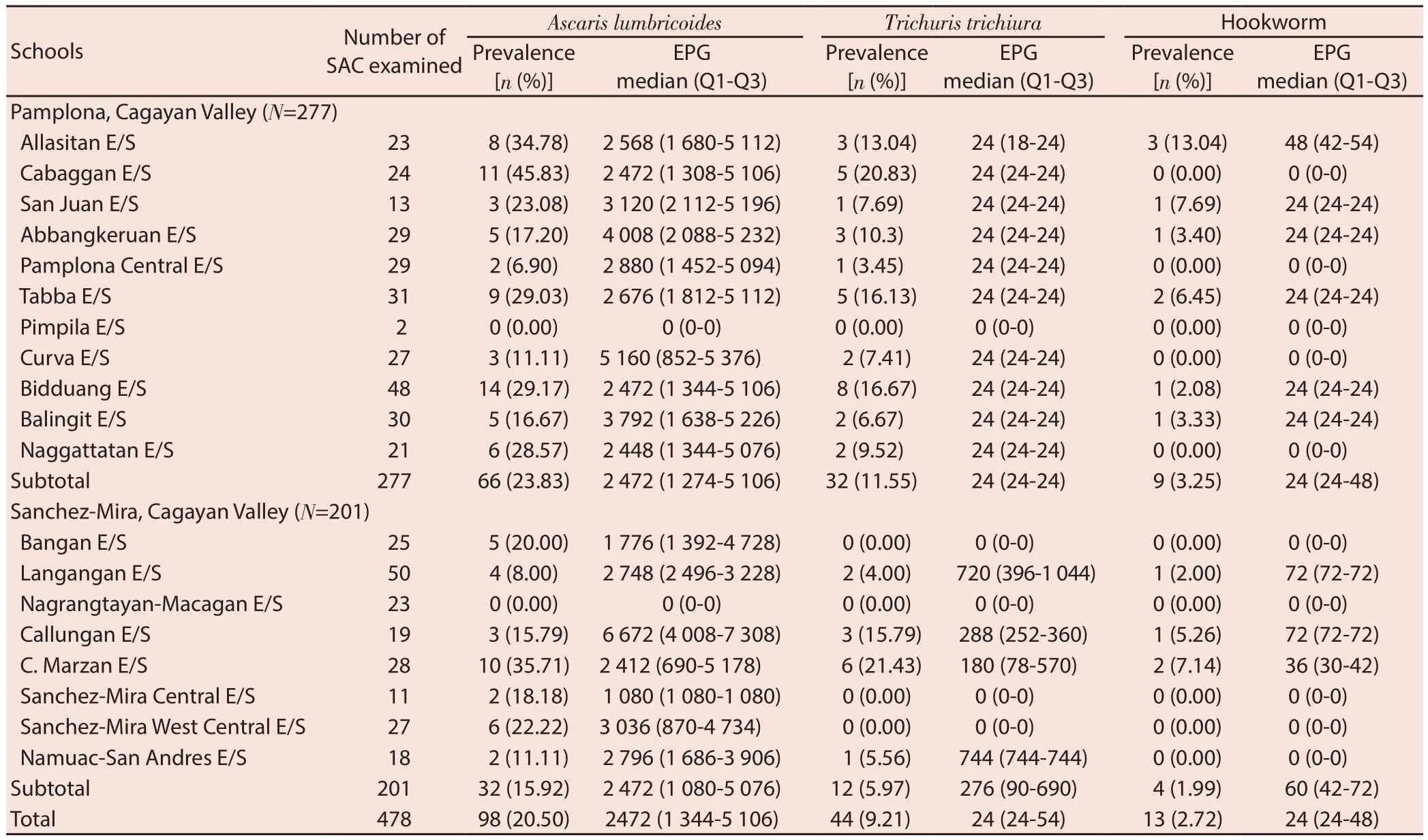
Table 3. Prevalence rate and intensity of infection per STH species, per school.
3.3. Knowledge, attitude, and practices of school-age children toward soil-transmitted helminthiasis
The knowledge, attitude, and practices toward STH of the SAC in the Cagayan Valley are presented in Table 4. All the SAC were familiar with the STH when it was called on its local term ‘a(chǎn)ryik”but they showed low scores when asked about its several types/species (5.86%-10.25% positive responses) and the modes of transmission (4.39%-9.62% positive responses). Despite the low percentage of SAC who were aware about the round worm, the whipworm, and the hookworm, intestinal worms in general were perceived by the SAC being integrated into the school discussions.This knowledge was obtained by them at school (54.60%), at home(36.62%), via television (35.15%), and from books (12.55%). In terms of perceived symptoms, stomach ache (62.97%) was the most identified by the SAC, followed by the difficulty in defecating(36.61%), diarrhoea (27.62%), and loss of appetite (23.22%). Only 5.02% of the SAC did not know any symptoms of intestinal worms.A low level of awareness was also observed on the knowledge about STH transmission. Many (21.55%) of them did not know any mode of STH transmission. The cause of STH infections as perceived by the SAC was due to eating contaminated food (9.62%). Only 4.39%of the SAC were aware that walking barefooted can contract STHinfection. Other perceptions that emerged as causes of the infection were eating junk foods and eating sweet foods, which was presumed by the researchers as a result of traditional Filipino parenting practice wherein scare factors are associated with unhealthy food intake.
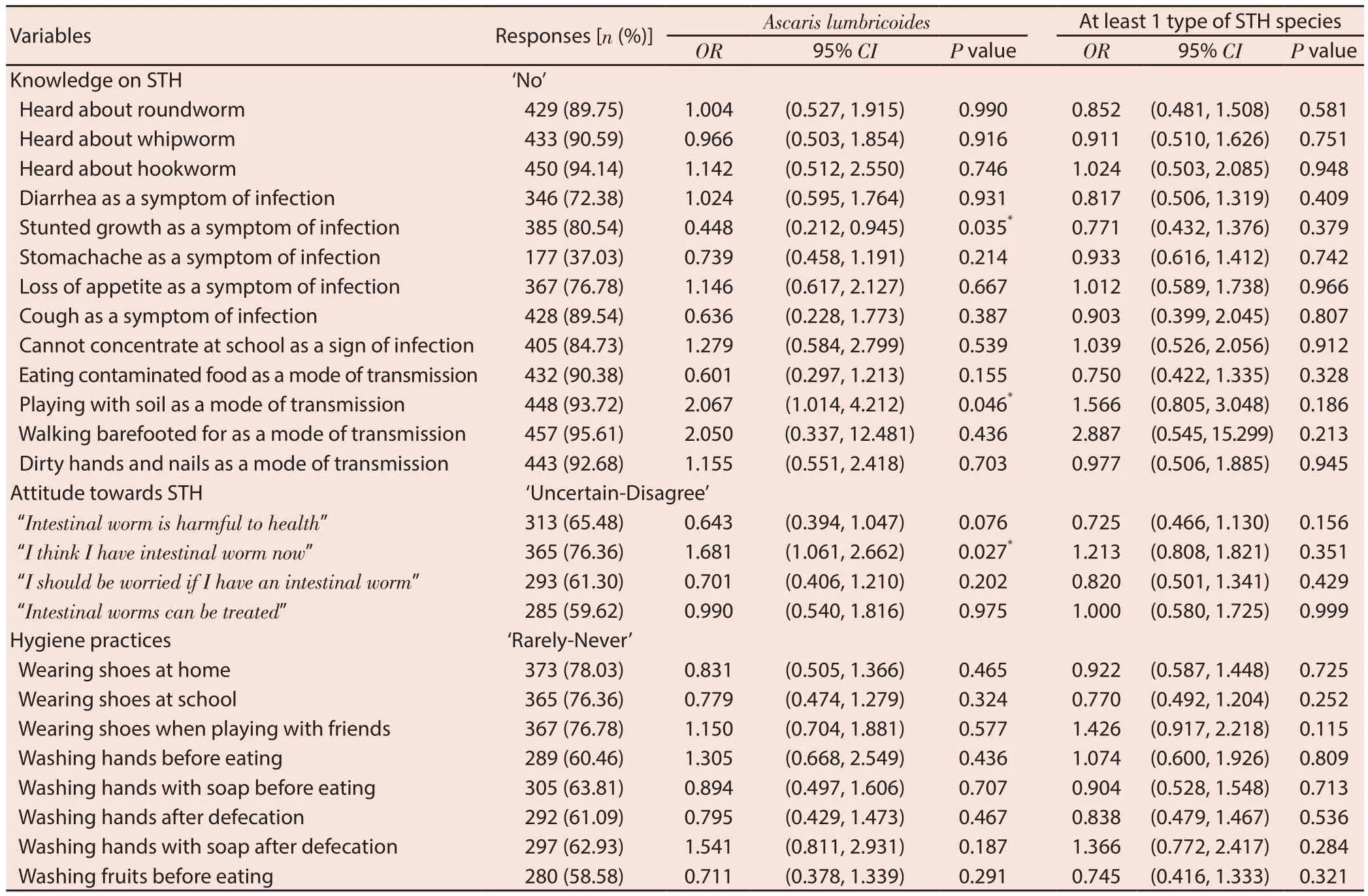
Table 4. Association between knowledge, attitude and practices toward STH and STH infections among the SAC in Cagayan Valley via logistic regression analysis (N=478).
In terms of attitude, 165 (34.52%) SAC believed that intestinal worm is harmful to one’s health, but 193 (40.38%) believed that the disease can be treated. Only few (23.64%) of the SAC believed that they might harboring intestinal worms at the time they answered the questionnaire and in case they were actually infected, 293 (61.30%) will not worry.
In regard to hygiene practices, wearing shoes at home was the least option of the SAC (21.94). Many SAC wore slippers at school(76.36%) and they habitually practiced walking barefooted during recess. Almost half (39.54%) of the SAC washed their hands before eating, but a decline of response rate (36.19%) was observed when asked if they use soap in washing their hands. The same trend was observed in washing hands after defecation (38.91%) and washing hands with soap after defecation (37.87%). Lastly, more than half of the respondents (58.58%) did not wash fruits before eating.
The association of KAP and STH infections was estimated using a logistic regression model. A. lumbricoides infection was used as a dependent variable in the analysis because it was the most prevalent STH infection across the participating elementary schools. Three predictors of Ascaris lumbricoides infection came out statistically significant at 5% significance level. In terms of knowledge two variables are statistically significant, namely (1)being unaware that stunted growth is a symptom of infection (OR 0.448; 95% CI 0.212, 0.945; P=0.035) and being unaware that the infection can be transmitted through playing with soil (OR 2.067;95% CI 1.014, 4.212; P=0.046). In terms of attitude, not believing of having intestinal worm during the time they answered the KAP questionnaire (OR 1.681; 95% CI 1.061, 2.662; P=0.027) was statistically significant predictor of Ascaris lumbricoides infection.
Logistic regression was also conducted to estimate the association of KAP responses and infection of at least 1 type of STH species(either with A. lumbricoides, T. trichiura or hookworm), but no variables were found statistically significant. Irrespective of the logistic regression analysis, it was evident in the low percentage of correct/positive responses in the KAP questions that the SAC in the Cagayan Valley needs intervention in terms of acquiring knowledge about STH and developing good attitude and practices toward STH infection.
4. Discussion
The global efforts to eliminate STH as a public health issue have reached the Cagayan Valley, but like the other regions of the country,its impact is not well-documented[27]. The prevalence rates reported in this study is not as high as other results of other studies, either in the Philippine setting or in other endemic nations. However, it cannot be concluded in this study as an impact of mass drug administration program due to the absence of baseline data in the area. According to the WHO, a group is at risk if the prevalence of STH infection exceeds 20% and treatment should be given at least once a year[28].Despite the implementation of the government programs on STH elimination in the area, the results of this study imply the need for further interventions in several elementary schools. Moreover, even the low prevalence and intensity rate of infection have also crucial implications in the 2020 goals of STH elimination. Preventive chemotherapy is highly prioritized in areas of high transmission, but in order to achieve total elimination, successful control intervention should be sustained in low transmission areas[17]. The low coverage of parasitologic assessment, as well as the inadequate monitoring of the value of interventions is not only a challenge in the Philippines,but also in many countries conducting STH elimination programs[14].Besides, a standardized diagnostic and reporting protocol that could strengthen the program implementation and decision-making has yet to be established. The 2020 roadmap of WHO showed a substantial progress in terms of preventive chemotherapy among SAC[14,17]but the utmost solution may not be covered by this global effort. There should have micromanagement efforts in a community level. It may start with ensuring SAC’s high level of awareness on STH and how to prevent their spread[29,30].
This study shows a need for the delivery of key health messages of STHs among SAC. Based on the identified low level of SAC’s knowledge, attitude, practices toward STH, the following are the important key health messages: (1) weakness (of the body) can be a sign of STH infection (2) coughing can be a sign of STH infection (3) seek help if you think you have STHs (4) avoid playing with soil (5) avoid walking barefooted (6) wear shoes at school(7) wash hands with soap before eating (8) wash hands with soap after defecation, and (9) wash fruits before eating, among others.The messages are focused on symptoms of the infection, attitude toward these symptoms, and the need to practice proper hygiene and sanitation. These key health messages should be delivered to the SAC in a simple manner where they can easily be understood and put into practice.
Aside from the common intervention efforts that are widely implemented across the globe, other innovative interventions can be done beyond the 2020 roadmap on STH elimination. One way is to influence the behaviour of the SAC through children’s art and literature. Several commercially available illustrated books for children in the country, like “Just add dirt” by Becky Bravo and “Where are my slippers” by Rene Villanueva may be tapped in formulating intervention strategies. The problem is the high cost and the inaccessibility of these books to the poor SAC[31]. The government should support artists and writers in producing these types of materials and incorporate it in the science framework of Philippine Basic Education. Currently, hygiene and sanitation is being taught in the elementary schools of the Cagayan Valley and are integrated in several subjects like Science and Health[27]. A comprehensive discussion of STH can be strategically incorporated in the basic education curriculum. From developing an inquiry-based skill like “What is a roundworm?” or “What is the difference between a roundworm and a hookworm?” to acquiring scientific attitude,“How can walking barefooted cause intestinal worm infection?” to aggregating content and connection, “...therefore, how can I avoid intestinal worm infections?” can be achieved by delivering the content in a creative manner.
Other possible ways to deliver the key health messages are the use of mobile application and social media. These are also used as a platform in promoting health issues among patients and healthcare professionals nowadays[32]. Facebook group is being used by several organizations as a tool for broadcasting knowledge-based content[33].It could be a promising tool to deliver messages on proper hygiene and sanitation, hand washing practices, and disease prevention,etc. The development of mobile games for children containing the key messages of Water, Sanitation and Hygiene can also be a great prospect. More research with the aim to produce effective, relatable,and enjoyable tools in educating SAC toward proper hygiene and sanitation is needed especially in the area where elimination of STH is almost achievable. As the global agenda, set by the health sector,is being updated from time to time, other timely efforts should be maximized both in the community and in the school.
The prevalence of STH infection in two school districts poses a public health risk. Preventive chemotherapy is needed, but based on the identified low level of KAP toward STH, integrated control strategies may include preventive chemotherapy together with effective health education that can influence the behaviour of the SAC toward hygiene and sanitation. The key messages for proper hygiene and sanitation may be delivered using the arts and culture sector in the country and may further be delivered by mobile applications or social media platforms.
Conflict of interest statement
We declare that we have no conflict of interest.
Acknowledgements
The research team acknowledges the Commission on Higher Education for funding this research through its K to 12 Transition Program Management Unit, under Discovery Applied Research and Extension for Trans/Interdisciplinary Opportunities Grant-in-Aid 2017 (Project Number: DARETO2-043). The authors wish to extend their heartfelt thanks to the people of Cagayan especially to the Pamplona mayor, Hon. Arnie Angelica Sampaga and Mira-Sanchez mayor, Hon. Asela Sacramed for giving us permission to conduct the study in their municipalities. We also would like to thank all the school heads, teachers, parents, and the health practitioners in Pamplona Rural Health Unit for allowing us to use their facilities during onsite detection of parasites.
Funding
Commission on Higher Education, K to 12 Transition Program Management Unit, under Discovery Applied Research and Extension for Trans/Interdisciplinary Opportunities (DARE TO) Grant-in-Aid 2017 (Project Number: DARETO2-043).
Authors’ contributions
R.V.L. designed the study. R.V.L., V.A.R., A.M.G., A.N.C., K.D.U.,A.J.C.R., K.L.S., K.J.S.C., and L.J.M.A conducted data gathering and laboratory analysis. All authors analyzed and interpreted the data and results. R.V.L., K.L.S., and K.J.S.C., drafted and critically revised the manuscript. All authors contributed to the final version of the manuscript.
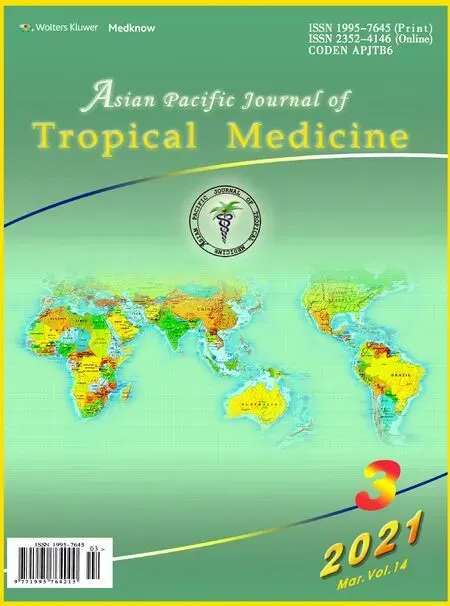 Asian Pacific Journal of Tropical Medicine2021年3期
Asian Pacific Journal of Tropical Medicine2021年3期
- Asian Pacific Journal of Tropical Medicine的其它文章
- Genotype 4 reassortant Eurasian avian-like H1N1 swine flu virus: An emerging public health challenge
- SARS-CoV-2 may impair pancreatic function via basigin: A single-cell transcriptomic study of the pancreas
- Burkholderia pseudomallei infection manifests as mediastinal/hilar lymphadenopathy:A case report
- In vitro anti-plasmodial activity of new synthetic derivatives of 1-(heteroaryl)-2-((5-nitroheteroaryl)methylene) hydrazine
- How knowledge of hepatitis B disease and vaccine influences vaccination practices among parents in Ho Chi Minh City, Vietnam
- Prevalence of cryptosporidiosis in animals in Iran: A systematic review and metaanalysis
